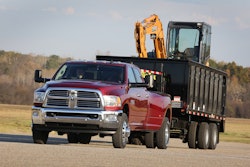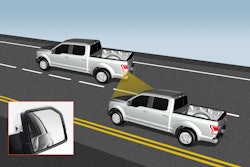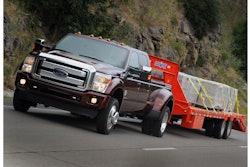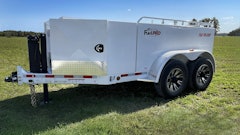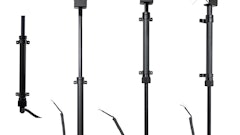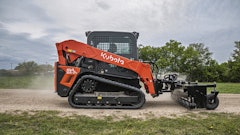
Originally published in September 2010 and Updated in October 2021.
Often overlooked, optional gear ratios play a key role in pickup truck performance. If the axle ratio is too tall, the truck may seem to lack power, especially when climbing hills. This may be corrected with a numerically higher axle ratio, often at the expense of unladen highway fuel economy.
Consider that with a 3.31 axle ratio, the driveshaft turns 3 1/3rd times for every revolution of the rear wheel. With a 4.30 ratio, it turns 4 1/3rd times for every revolution of the rear wheel. The numerically higher gear ratio (in this case, 4.30) increases wheel torque and improves acceleration from low speeds. But the engine does have to run faster to achieve a given speed.
Video: How a Differential Works
Selecting the best gear ratio can be tricky as the entire powertrain works as a system. Every engine includes a sweet spot in its power curve between peak power and peak torque. You want the transmission gearing and axle gear ratio to stay in this sweet spot while hauling the payload at the desired speed.
Also consider that the axle ratio is only a portion of the overall pickup gearing. Manufacturers spend a lot of effort on powertrain matching. According to Ford Motor Company, powertrain matching is really a systems approach. It is the engine, transmission, axles and tires working together. It is the effective ratio of engine power transmitted all the way through the drive system to the ground.
The March Toward More Gears
Relying on past history to select an axle ratio may not be the best approach as technology continues to change. There has been a major evolution in pickup truck transmission offerings as manufacturers pack an increasing number of gears into the transmission housing. Many years ago, the four-speed automatic transmission was mainstream. Then it evolved into five speeds and eventually six speeds. The terrain, the weight of your loads, the shape of your loads and how often you tow will all influence the correct axle ratio.Ram Trucks
The terrain, the weight of your loads, the shape of your loads and how often you tow will all influence the correct axle ratio.Ram Trucks
In 2012, Ram Trucks introduced an eight-speed transmission for its 2013 1500 models. This evolution of pickup truck transmissions accelerated in 2017 with the introduction of 10-speed transmissions. This was the result of a collaboration between Ford and General Motors, and first appeared as an option on the 2017 F-150 pickups. Chevrolet Silverado 2019 pickup truck models followed. For 2020, Ford and General Motors both introduced new 10-speed transmissions on their heavy-duty pickups.
Previously mainstream six-speed automatic transmissions are currently being replaced by eight- and 10-speed transmissions, which are able to provide closer ratios between the gears. “Closer ratios allow for the right gear at the right time and can reduce gear hunting on grades and help take advantage of the engine torque curve,” says Rod Romain, chief engineer, Ram Heavy Duty.
The ultimate goal of a transmission is to keep the engine working in its most efficient speed range, or at the highest torque point when performance is needed. The transmission’s computer does whatever it takes to find the gear that keeps the engine in its most efficient or best-performing speed range. By having more gear ratios, it is possible to keep an engine near its ideal operating speed most of the time. The transmission’s wider overall ratio enables a lower numerical top gear ratio, an attribute that reduces engine speed on the highway.
“Simply, closer ratios may not support a lower numeric axle; it’s a system with the engine,” says Romain. “If the ratio selection works with the engine, sometimes a lower numeric axle ratio can be used and actually improve the overall towing experience. It’s a system with the engine and vehicle. They need to work together for the task at hand and, depending upon the transmission ratios, a higher numerical ratio in a higher gear may be the same as a lower numerical axle in a lower gear.”
The way people spec rear axle ratios has changed as the powertrains have evolved over the past few years. “Years ago, 4.56 and 4.10 were the only gears to have when towing heavy,” notes Romain. “With the improved engine performance we have today, the same loads and even higher can be pulled with much lower numerical ratios.”
According to Ford Motor Company, there are interconnected reasons to choose optional axle ratios — if you are hauling heavy loads with large trailers in hilly terrain and you do a high frequency of towing. Consider a PowerStroke 6.7-liter diesel that offers a choice of a 3.31, 3.55, 3.73 or 4.30 axle ratio. The 3.31 might be capable of towing the trailer. But if you are towing the majority of the time, you probably want the 3.55 because it will tow better and provide better fuel economy loaded.
Fuel Economy vs. Towing Efficiency
Start with the total combined weight of the vehicle, then consider the environment. If you drive the vehicle on flat ground in Iowa throughout its life, axle ratio is not as critical as pulling the same load up the hills in Denver. The axle ratio really starts to show when you get into grades. Higher numerical axle ratios can increase performance when towing heavy loads.
Higher numerical axle ratios can increase performance when towing heavy loads.
Note that pickup tow and haul ratings are listed by axle ratio. The vehicle’s tow rating vs. what you plan on towing is the best way to determine which gear ratio you should select.
The consumer can tailor the vehicle’s driveline to meet their particular needs, according to Toyota Motor Vehicles. If you will never have more than 1,000 lbs. in the back of the truck, you would want the highest ratio (3.73 instead of 4.30) for improved fuel economy because you will not need the torque. However, if you are towing a 9,000-lb. trailer, you will need that extra torque to get the trailer moving, especially up steep grades (4.30 instead of a 3.73).
Fuel economy (higher rpms translate to increased fuel use), the weight to be towed or hauled (you want the engine to stay at an efficient speed on hills), roads traveled (steep grades vs. flat highway) and expected speed are all factors to consider when choosing the correct ratio, advises Ram Trucks. You may choose a ratio that keeps the engine at the lowest rpm for fuel economy. But if you are not traveling fast enough on the highway, it will lug the engine and prove to be less efficient. You want to keep the engine at the most efficient rpm for a set speed, no matter what the load.
Consider the top speed at which you want to drive, the fuel economy you wish to achieve at that highway speed and the load you intend to tow or haul. For example, if you wish to tow 10,000 lbs. at 55 mph on flat highway, a mid gear ratio will keep the engine rpms up enough to maintain power with efficiency. If you want to drive at a high rate of speed, go with a smaller numerical gear ratio to keep the rpms as low as possible.
Towing a heavy load and fuel economy don’t go hand in hand, according to General Motors. The lower gear ratio will give you the drivability you need to effectively tow the load at the expense of slightly higher engine rpm at higher speeds vs. a vehicle with a higher ratio. However, if you use a final drive ratio that is too high, you will have to rev the engine more and the transmission clutches will generate much more heat due to slipping when trying to get the load moving. The end result is you damage your transmission.
The weight of the load isn’t the only consideration. It is the weight of the load as well as the aero characteristics of the load, notes General Motors. If you pull a large trailer that has a large frontal area, it has a very high aero impact going down the highway compared to a flatbed trailer with a Bobcat and lawn servicing equipment. The aero characteristics are quite different for those two vehicles, and that has a huge impact on towing on the highways.
Performance Relative to Use
General Motors previously performed extensive testing with its L96 gas engine and both the standard 3.73 and optional 4.10 axle ratios. That 3.73 vs. a 4.10 has a huge impact on engine rpm because you are selecting second gear with a 3.73 to pull the grade, but you can hit third gear with a 4.10. Your engine speed is about 1,000 rpm lower, so temperatures under hood are going to be significantly lower.
Higher numerical ratios often increase fuel consumption. The penalty in fuel economy varies because it depends so much on your use, Ford Motor Company points out. If you drive the vehicle with low loads, you will see a fuel economy decrease with a higher numerical axle ratio, particularly at highway speeds. If you are driving loaded a lot of the time, there is a point where fuel economy crosses over and is equivalent or even better. If you are driving in a city environment at slower speeds, you may also see a fuel economy increase with a higher numeric axle ratio.
Many dedicated commercial trucks do not offer a choice of axle ratios. One ratio is used since the trucks are primarily being used for a commercial-type application where they are all heavily loaded.
Tire Size Changes Ratios
Changing tire size also affects the gear ratio. A larger tire plays the same role as smaller gear ratios. However, you now may be adding rotating mass, which decreases efficiency and also negatively changes the dynamics of the vehicle for which it was designed.
A 1-in. decrease in tire diameter has about the same impact of 1/3rd of an axle step. For example, if a 3.73 axle ratio currently is matched with a 31.2-in.-diameter tire, then the tire is decreased to 30.2 in., the revolutions per mile increase from 650 to roughly 670. That gives you about a 3.85 axle ratio.
Keep in mind that vehicles are designed to be operated with a specific-sized tire. Most manufacturers don’t recommend changing tire size, as this will affect handling and performance of the vehicle.
Impact on Wear and Tear
A higher numerical gear ratio doesn’t automatically reduce wear and tear under heavy loads.
Energy must be transferred somewhere, notes Ram Trucks. The wear and tear will increase in one area and drop in another depending upon what the load is and the drive cycle. Most wear and tear is dependent upon driving habits, e.g., slipping the clutch, jack-rabbit starts, over- and/or under-revving the engine, etc.
But a higher numerical ratio will save wear on both the engine and transmission. It is more of a benefit to the transmission because it will have a greater mechanical advantage over the load when trying to get the load moving.
The recent proliferation of transmissions with more gears makes the overall gearing more effective. Multiple speeds give multiple options to keep the engine in the most efficient operating range at a particular speed.
It’s all about balance. A manufacturer may choose a 3.73 because it knows the customer of a heavy-duty truck is going to tow, but isn’t going to tow a 20,000-lb. combined package. So, the manufacturer tries to provide the best performance with a 3.73. Then there is the customer that has the 3500 dually; it has the small 17-in. tire and 4.10 axle ratio. This will give the customer the best performance for the 20,500-lb. combined package.
The best advice is to fully understand your application. The axle selection also impacts many factors other than fuel economy. That axle ratio is key to thermal performance. If you are going to tow a lot of weight, the higher numerical gear ratio will actually improve the durability of the vehicle.
“Match the tow rating of your vehicle to the task you are asking it to do and you will be fine,” says Romain.

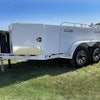


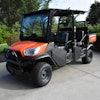
![[VIDEO] 2017 Ram Power Wagon Revealed at Chicago Auto Show](https://img.forconstructionpros.com/files/base/acbm/fcp/image/2016/02/default.56bd2b8a00e9b.png?auto=format%2Ccompress&fit=crop&h=167&q=70&w=250)
